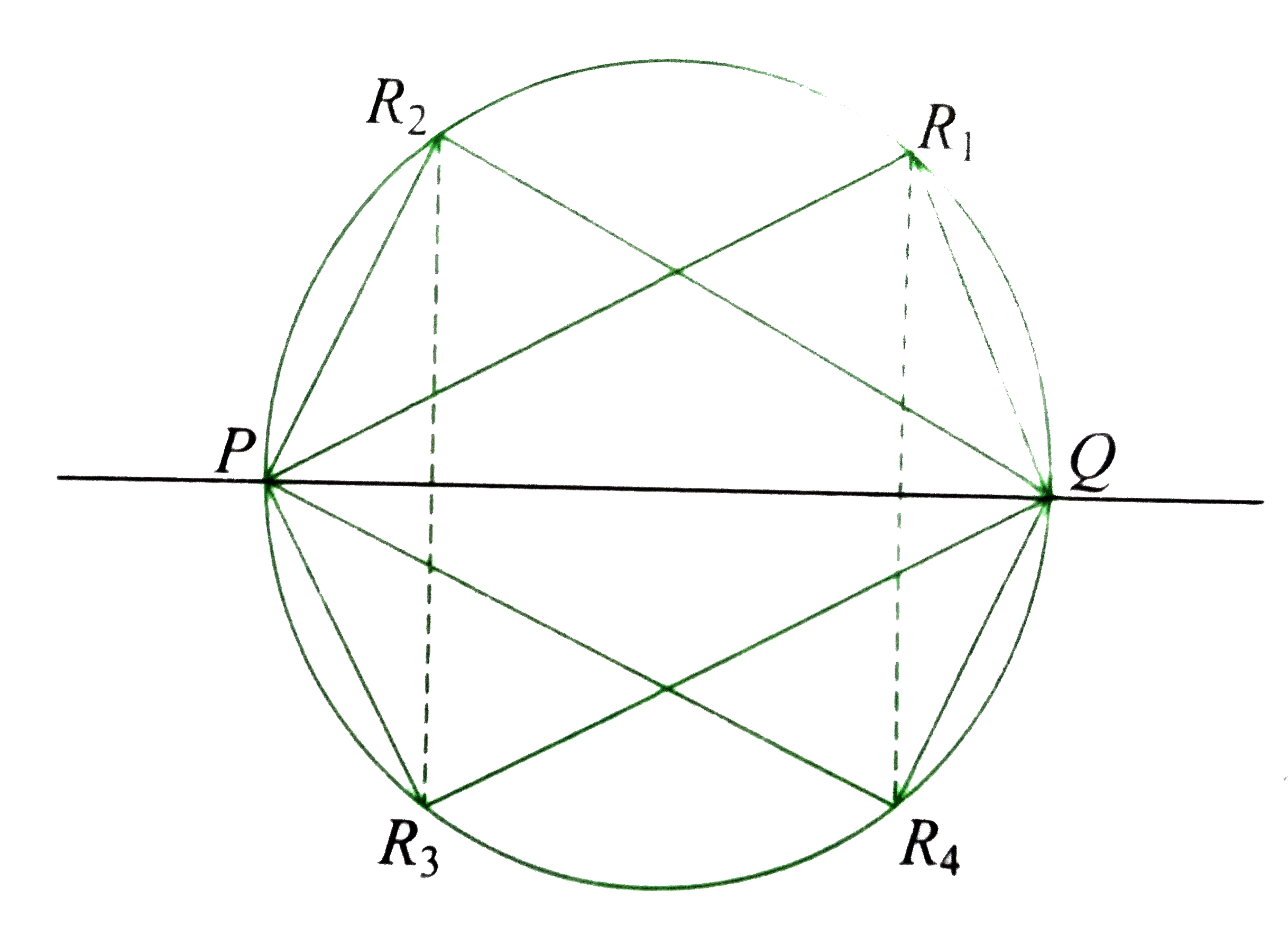If f:R→N∪{0}, where f (area of triangle joining points P(5,0),Q(8,4)andR(x,y) such that angle PRQ is a right angle) = number of triangles, then which of the following is true? (a) f(5)=4 (b) f(7)=0 (c) f(6.25)=2 (d) f(x) is intoSolution in Bengali
The correct Answer is:A, B, C, D
Hence∠PRQ=π/2 and points P, Q, R lie on the circle with PQ as diameter.
Also, PQ=5.

Now, the maximum area of the triangle is
Δmax=12(5)(52)=6.25
For area = 5, we have four symmetrical positions of point R (shown as R1,R2,R3,R4).
For area = 6.25, we have exactly two points.
For area = 7, no such points exist.
Topper's Solved these Questions
Similar Questions
Let ABCandABC' be two non-congruent triangles with sides AB=4,AC=AC′=2√2 and angle B=300 . The absolute value of the difference between the areas of these triangles is
View SolutionNumber of integral value(s) of λ for which vectors x2ˆi−ˆj+xˆk,(λ−1)ˆi−2λˆj−ˆk and ˆi−ˆj+ˆk, in the order form right-handed system ∀x ∈R, is
(a) 0 (b) 2 (c) 4 (d) 6
View SolutionIf f:R→N∪{0}, where f (area of triangle joining points P(5,0),Q(8,4)andR(x,y) such that angle PRQ is a right angle = number of triangles, then which of the following is true? f(5)=4 (b) f(7)=0 f(6,25)=2 (d) f(x)is¬
View SolutionLet f(x) be a polynomial such that f(0)=2,f'(0)=3andf''(x)=f(x)andf'(4)=5α+12β,f(2)=5γ−12δ then
View SolutionLet f:N∪{0}→N∪{0} be defined by f(n)={n+1, if n is even, n−1, if n is odd Show that f is invertible and f=f−1 .
View SolutionIf Delta=det[[f(x),f((1)/(x))+f(x)1,f((1)/(x))]]=0 where it is given f(x)=a+bx^(n) and f(2)=17 and f(5)=K then K-620=
View SolutionLet f(x+y)=f(x)⋅f(y) for all x y where f(0)≠0 .If f(5)=2 and f'(0)=3 then f'(5) is equal to
View SolutionIf f:R→R is defined by
f(x)=⎧⎪⎨⎪⎩x+4 for x<−43x+2 for −4≤x<4x−4 for x≥4
then match the following columns and choose the correct answer.
column Icolumn II(A)f(−5)+f(−4)(1)14(B)f(|f(−8)|)(2)4(C)f(f(−7))+f(3)(3)−11(D)f(f(f(0)))+1(4)−1(5)5(6)0
View SolutionLet f:N∪{0}→N∪{0} be defined by f(n)={n+1, if n is even, n−1, if n is odd Show that f is invertible and f=f−1 .
View SolutionIf f:R→NUU{0} where f (area of triangle joining points P( 0,5) , Q( 8,4) and R(x,y ) such that angle PRQ is a right angle) = number of triangle , then which of the following is true?
View SolutionLet f(x+y) = f(x) . f(y) for all x,y where f(0) ≠ 0. If f(5) =2 and f'(0) =3 , then f'(5) is equal to
View SolutionIf f(x)=tanx and A,B,C are the angles of △ABC, then ∣∣ ∣ ∣ ∣ ∣∣f(A)f(π4)f(π4)f(π4)f(B)f(π4)f(π4)f(π4)f(C)∣∣ ∣ ∣ ∣ ∣∣=
View SolutionIf Δ=∣∣ ∣ ∣∣f(x)f(1x)+f(x)1f(1x)∣∣ ∣ ∣∣=0 where it is given f(x)=a+bxn and f(2)=17 and f(5)=K then K−620=
View SolutionIf f(x+y)=f(x)f(y) for all x and y, f(6)=3andf'(0)=10, then f'(6) is :a)30 b)13 c)10 d)0
View SolutionIf the function / satisfies the relation f(x+y)+f(x−y)=2f(x),f(y)∀x,y∈Randf(0)≠0 , then (a) f(x)isanevenfunction (b) f(x)isanoddfunction (c) If f(2)=a ,then f(-2)=a(d)Iff(4)=b,thenf(−4)=−b
View SolutionLet f:R→R be a continuous onto function satisfying f(x)+f(−x)=0∀x∈R. If f(−3)=2andf(5)=4∈[−5,5], then the minimum number of roots of the equation f(x)=0 is
View Solution
